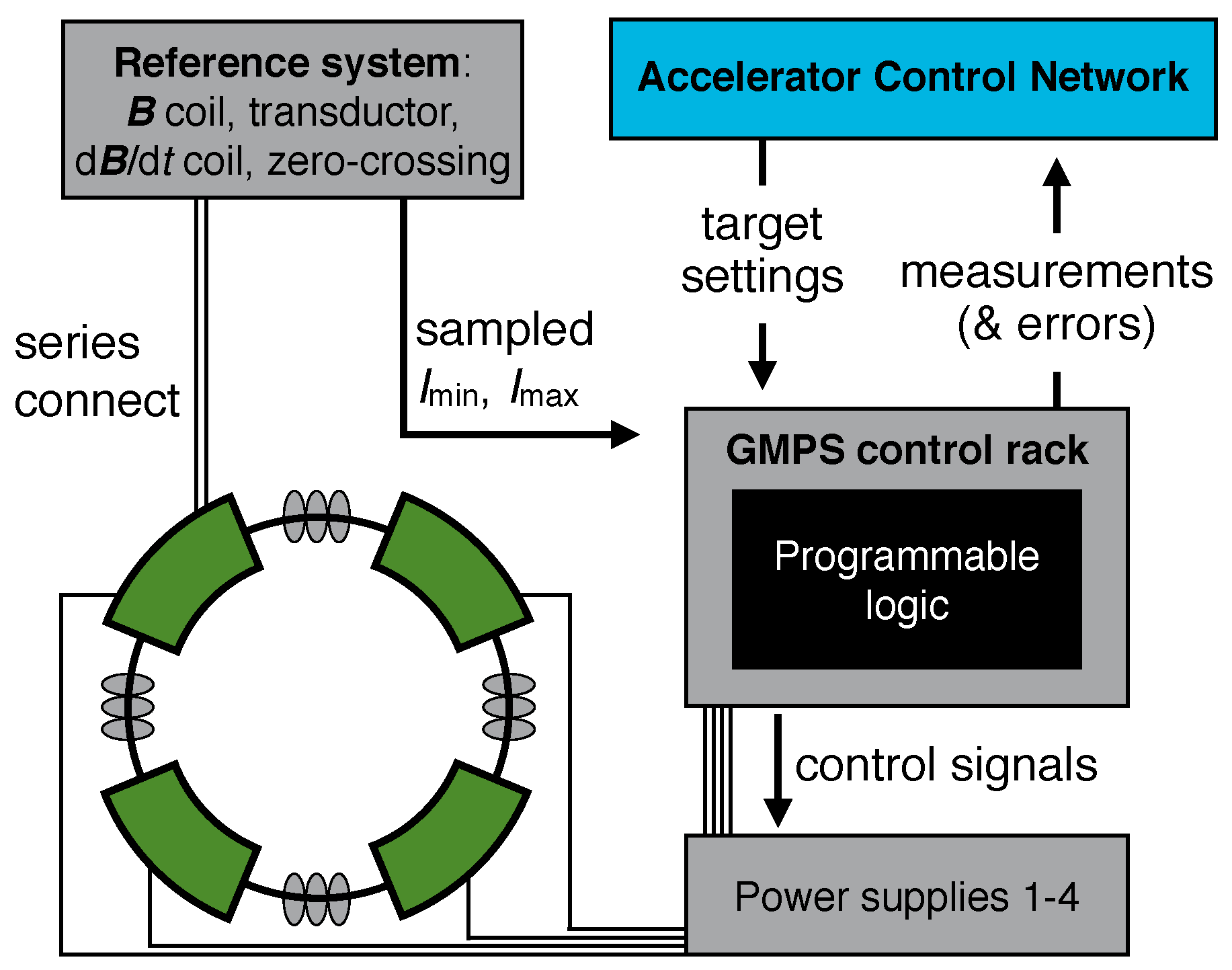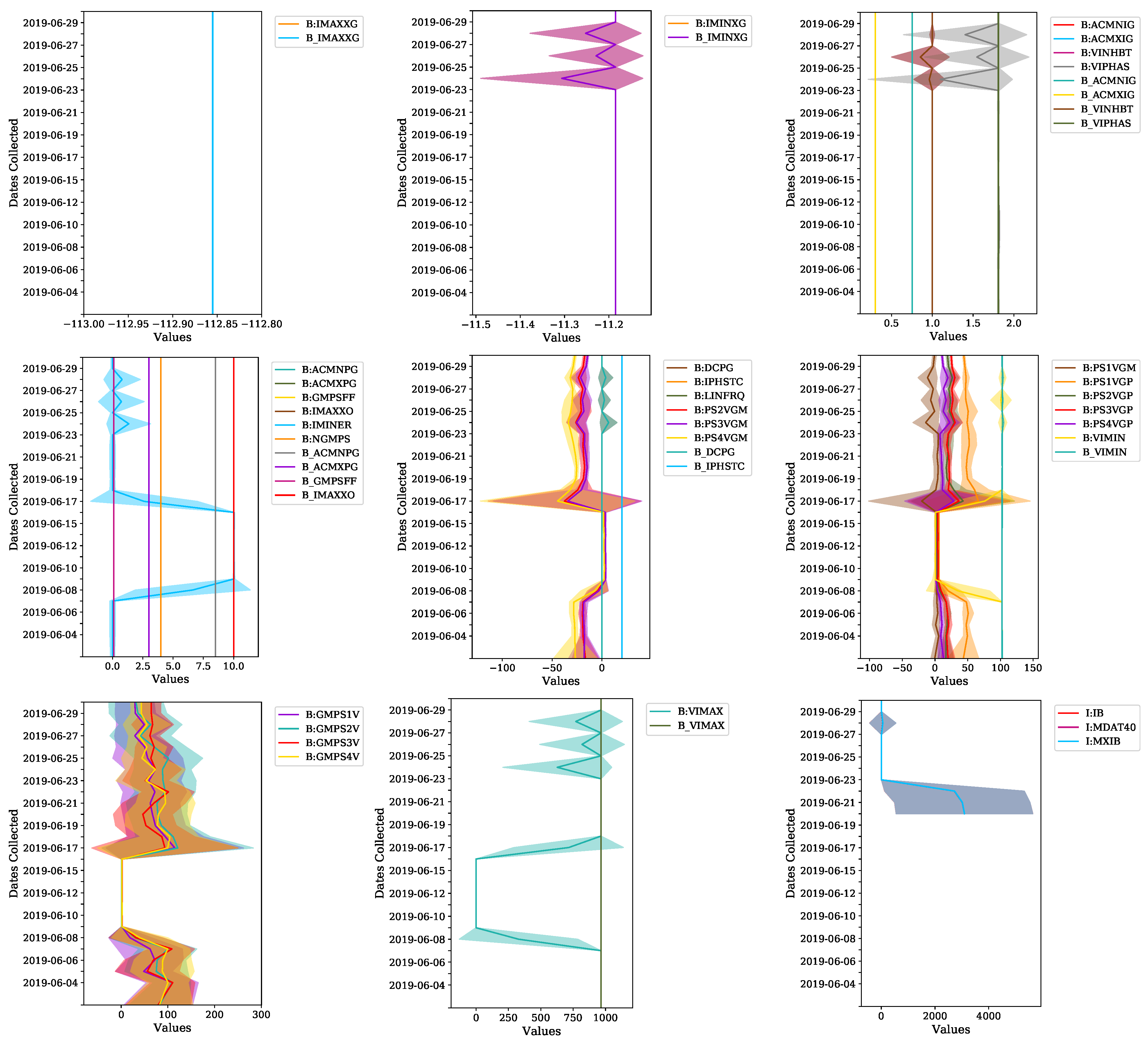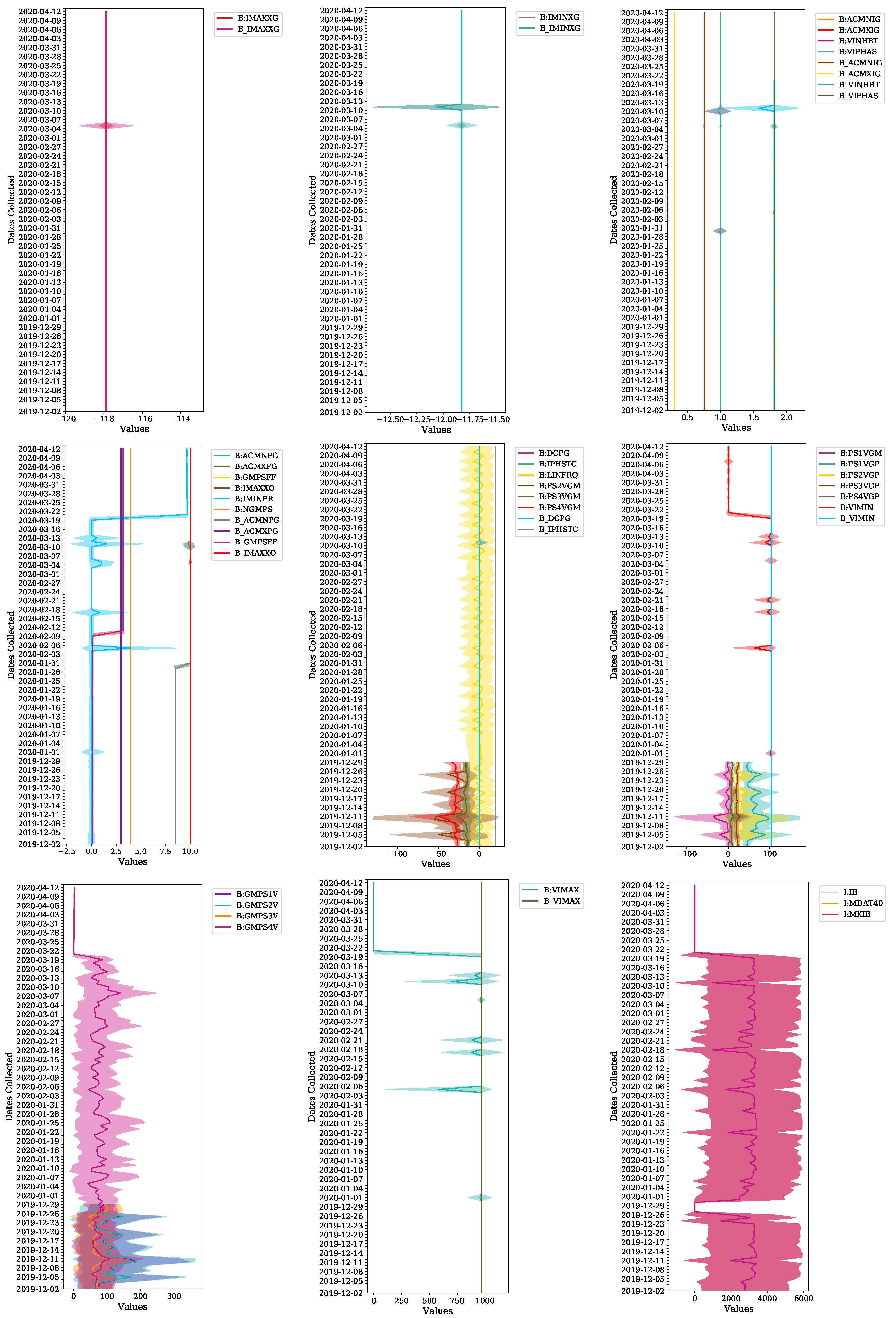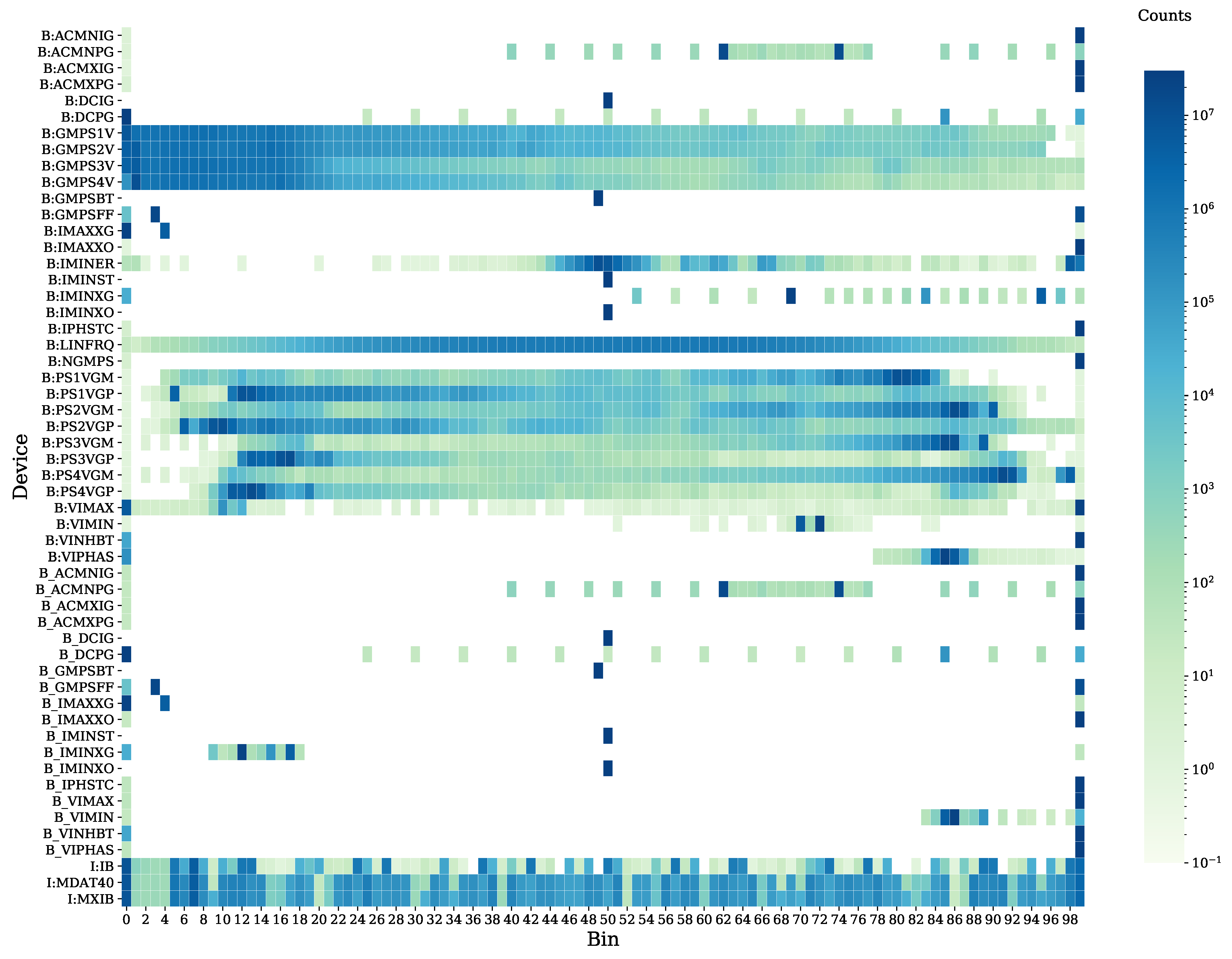BOOSTR: A Dataset for Accelerator Control Systems
Abstract
:1. Introduction
2. Methods
2.1. Collection Process
2.2. Data Processing
3. Data Description
4. Technical Validation
5. Usage Notes
Author Contributions
Funding
Institutional Review Board Statement
Informed Consent Statement
Data Availability Statement
Acknowledgments
Conflicts of Interest
References
- John, J.S.; Herwig, C.; Kafkes, D.; Pellico, W.A.; Perdue, G.N.; Quintero-Parra, A.; Schupbach, B.A.; Seiya, K.; Tran, N.; Duarte, J.M.; et al. Real-time Artificial Intelligence for Accelerator Control: A Study at the Fermilab Booster. arXiv 2020, arXiv:2011.07371. [Google Scholar]
- Cahill, K.; Carmichael, L.; Finstrom, D.; Hendricks, B.; Lackey, S.; Neswold, R.; Nicklaus, D.; Patrick, J.; Petrov, A.; Schumann, C.; et al. The Fermilab Accelerator Control System. ICFA Beam Dyn. Newsl. 2008, 47, 106–124. [Google Scholar]
- Kafkes, D.; St. John, J. BOOSTR: A Dataset for Accelerator Control Systems (Full Release 2020). 2021. Available online: https://0-doi-org.brum.beds.ac.uk/10.5281/zenodo.4382663 (accessed on 15 April 2021).
- Kafkes, D.; St. John, J. BOOSTR: A Dataset for Accelerator Control Systems (Partial Release 2020). 2020. Available online: https://0-doi-org.brum.beds.ac.uk/10.5281/zenodo.4088982 (accessed on 15 April 2021).
- Hazelwood, K.J. Fermilab Electronic Logbook. Available online: www-bd.fnal.gov/Elog (accessed on 15 April 2021).







| Parameter | Details (Units) | Setting | Mean (Std) | Missing Dates |
|---|---|---|---|---|
| B:ACMNIG | Min AC integral feedback gain | B_ACMNIG | 0.75 (0) | 2019: 6/14, 12/12 |
| B:ACMNPG | Min AC proportional feedback gain | B_ACMNPG | 9.1968 (0.75) | 2019: 6/14, 12/12 |
| B:ACMXIG | Max AC integral feedback gain | B_ACMXIG | 0.30 (0) | 2019: 6/14, 12/12 |
| B:ACMXPG | Max AC proportional feedback gain | B_ACMXPG | 3.00 (0) | 2019: 6/14, 12/12 |
| B:DCIG | DC integral feedback gain | B_DCIG | 0 (0) | 2019: 6/14, 12/12 |
| B:DCPG | DC proportional feedback gain | B_DCPG | 0.10 (1.35) | 2019: 6/14, 12/12 |
| B:GMPS1V | GMPS1 output voltage (V) | 81.82 (89.56) | 2019: 6/14, 12/12, 12/30–31 | |
| and 2020: 1/01–4/12 | ||||
| B:GMPS2V | GMPS2 output voltage (V) | 85.29 (96.00) | 2019: 6/14, 12/12, 12/30–31 | |
| and 2020: 1/01–4/12 | ||||
| B:GMPS3V | GMPS3 output voltage (V) | 63.67 (61.19) | 2019: 6/14, 12/12, 12/30–31 | |
| and 2020: 1/01–4/12 | ||||
| B:GMPS4V | GMPS4 output voltage (V) | 61.08 (65.19) | 2019: 6/14, 12/12 | |
| B:GMPSBT | offset trigger (s) | B_GMPSBT | 0 (0) | 2019: 6/14, 12/12 |
| B|GMPSSC | Binary status control of GMPS | N/A (N/A) | 2019: 6/07, 6/12, 6/14–15 | |
| and 2020: 1/18, 3/08, 3/15 | ||||
| B:GMPSFF | Feedforward start trigger (s) | B_GMPSFF | 1.32 (1.52) | 2019: 6/14, 12/12 |
| B:IMAXXG | Max transductor gain (A/V) | B_IMAXXG | −117.12 (1.80) | 2019: 6/14, 12/12 |
| B:IMAXXO | Max transductor offset (A) | B_IMAXXO | 10.00 (0) | 2019: 6/14, 12/12 |
| B:IMINXG | Min transductor gain (A/V) | B_IMINXG | −11.73 (0.23) | 2019: 6/14, 12/12 |
| B:IMINXO | Min transductor offset (A) | B_IMINXO | 0 (0) | 2019: 6/14, 12/12 |
| B:IMINER | Discrepancy from setting at min (0.1 A) | 1.93 (3.86) | 2019: 6/14, 12/12 | |
| B:IMINST | sample off | B_IMINST | 0 (0) | 2019: 6/14, 12/12 |
| B:IPHSTC | Phase regulator time constant | B_IPHSTC | 20.00 (0.01) | 2019: 6/14, 12/12 |
| B:LINFRQ | 60 Hz line frequency offset (mHz) | −0.44 (16.31) | 2019: 6/03–7/11, 12/12 | |
| 12/30–31 and 2020: 1/01–06 | ||||
| B:NGMPS | Number of GMPS suppliers | 4.00 (0) | 2019: 6/14, 12/12 | |
| B:PS1VGM | GMPS1 V− to ground (V) | −2.30 (23.56) | 2019: 6/14, 12/12, 12/30–31 | |
| and 2020: 1/01–4/12 | ||||
| B:PS2VGM | GMPS2 V− to ground (V) | −21.29 (27.52) | 2019: 6/14, 12/12, 12/30–31 | |
| and 2020: 1/01–4/12 | ||||
| B:PS3VGM | GMPS3 V− to ground (V) | −15.13 (14.11) | 2019: 6/14, 12/12, 12/30–31 | |
| and 2020: 1/01–4/12 | ||||
| B:PS4VGM | GMPS4 V− to ground (V) | −26.27 (17.22) | 2019: 6/14, 12/12, 12/30–31 | |
| and 2020: 1/01–4/12 | ||||
| B:PS1VGP | GMPS1 V+ to ground (V) | 52.00 (34.82) | 2019: 6/14, 12/12, 12/30–31 | |
| and 2020: 1/01–4/12 | ||||
| B:PS2VGP | GMPS2 V+ to ground (V) | 26.53 (30.53) | 2019: 6/14, 12/12, 12/30–31 | |
| and 2020: 1/01–4/12 | ||||
| B:PS3VGP | GMPS3 V+ to ground (V) | 20.17 (13.74) | 2019: 6/14, 12/12, 12/30–31 | |
| and 2020: 1/01–4/12 | ||||
| B:PS4VGP | GMPS4 V+ to ground (V) | 9.14 (12.75) | 2019: 6/14, 12/12, 12/30–31 | |
| and 2020: 1/01–4/12 | ||||
| B:VIMAX | Compensated max GMPS current (A) | B_VIMAX | 772.43 (385.98) | 2019: 6/14, 12/12 |
| B:VIMIN | Compensated min GMPS current (A) | B_VIMIN | 83.20 (40.68) | 2019: 6/14, |
| B:VINHBT | Inhibit value | B_VINHBT | 1.00 (0.04) | 2019: 6/14, 12/12 |
| B:VIPHAS | GMPS ramp phase wrt line voltage (rad) | B_VIPHAS | 1.80 (0.14) | 2019: 6/14, 12/12 |
| I:IB | MI lower bend current (A) | 2275.71 (2571.03) | 2019: 6/03–19, 12/12 | |
| I:MDAT40 | MDAT measured MI current (A) | 2400.57 (2576.37) | 2019: 6/03–7/11, 12/12 | |
| I:MXIB | Main dipole bend current (A) | 2279.68 (2564.53) | 2019: 6/03–11, 6/13–19, 12/12 |
| Device | Setting | Constant Value |
|---|---|---|
| B:DCIG | B_DCIG | 0 |
| B:GMPSBT | B_GMPSBT | 0.0003 |
| B:IMINST | B_IMINST | 0 |
| B:IMINXO | B:IMINXO | 0 |
| Date | Elog Entry Summary |
|---|---|
| 6/8/2019 | GMPS in AC mode until 8:00 AM (13:00) on 6/08, then switched off until 6/17 |
| 6/10/2019 | GMPS was locked/tagged out for outage, West Booster gallery RF off from 8:30–10:00 (13:30–3:00) for work |
| 6/17/2019 | GMPS turned back on and put in AC mode |
| 6/22/2019 | High energy physics beam turned off at 8:00 PM (1:00 + 1) (GMPS remained in AC mode) |
| 6/24/2019 | DC studies from 8:00 AM–6:00 PM (13:00–23:00), back to AC mode |
| 6/26/2019 | Alternated between AC and DC mode, GMPS off for 30 min around 5:30 PM (22:30) |
| 6/27/2019 | GMPS in AC mode all day, but removing certain study events caused bias to creep up, eventually tripping the RF |
| 6/28/2019 | Alternated between AC and DC mode |
| 12/8/2019 | B_VIMIN adjusted, GMPS in AC mode |
| 12/12/2019 | AC mode, operators reset virtual machine environment locally |
| 12/28–12/30/2019 | No beam from injector, GMPS in AC mode |
| 12/31/2019 | Booster injection back, GMPS in AC mode |
| 1/1/2020 | GMPS off for 15 min around 9:30 AM (14:30), in AC mode for rest of day |
| 2/4/2020 | RF sparking in gallery due to reverting of RF capture settings, GMPS in AC mode |
| 2/5/2020 | GMPS off from 6:00 AM–3:30 PM (11:00–20:30), then in AC mode for rest of day |
| 2/6/2020 | Lowered beam intensity to users, but GMPS was in AC mode all day |
| 3/5/2020 | Beam tails were large, so turned B_VIMIN down |
| 3/10/2020 | GMPS in AC mode all day, B:ACMNPG changed from 6.5 to 13.5, B_VIMIN decreased from 103.440 to 103.420 |
| 3/11/2020 | GMPS in AC mode from 12:00 AM–6:00 AM (5:00–11:00), off from 6:00–10:00 AM (11:00–15:00), then alternated between AC and DC mode, B_VIMIN adjusted from 103.418 to 103.386 |
| 3/13/2020 | GMPS off from 9:30 AM–11:00 AM (14:30–16:00), back on and put in AC mode |
| 3/20/2020 | Booster turned off on account of Covid-19 pandemic at 12:00 PM (17:00) |
Publisher’s Note: MDPI stays neutral with regard to jurisdictional claims in published maps and institutional affiliations. |
© 2021 by the authors. Licensee MDPI, Basel, Switzerland. This article is an open access article distributed under the terms and conditions of the Creative Commons Attribution (CC BY) license (https://creativecommons.org/licenses/by/4.0/).
Share and Cite
Kafkes, D.; St. John, J. BOOSTR: A Dataset for Accelerator Control Systems. Data 2021, 6, 42. https://0-doi-org.brum.beds.ac.uk/10.3390/data6040042
Kafkes D, St. John J. BOOSTR: A Dataset for Accelerator Control Systems. Data. 2021; 6(4):42. https://0-doi-org.brum.beds.ac.uk/10.3390/data6040042
Chicago/Turabian StyleKafkes, Diana, and Jason St. John. 2021. "BOOSTR: A Dataset for Accelerator Control Systems" Data 6, no. 4: 42. https://0-doi-org.brum.beds.ac.uk/10.3390/data6040042






